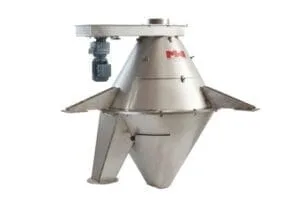RTD Product Brochure.

To find out more about our Rotary Tube Divider (RTD) please feel free to
download product brochure:
The Rotary Tube Divider (RTD) – or rotary sample divider – is designed for representative mass reduction of bulk material. The sample divider can be used for mass reduction of virtually any type of dry materials. It is a robust, all-round sub-sampling solution.
The RTD is used in many multi-stage sampling systems but may also be used as a stand-alone divider.
Variant 1 (standard): The Rotary Tube Divider Single (RTD-S) has one sample outlet in the bottom section.
Variant 2: The Rotary Tube Divider Multiple (RTD-M) have up to four sample outlets in the bottom section.
The RTD-M is used where several aliquot analyses are needed for each sample (e.g. moisture, PSD, FE-content) or where different quantities of sub-samples are needed for different sample outlets (e.g. 1:15 and 1:25) during the sampling operation.
The Rotary Tube Divider (RTD):
To learn more about M&W JAWO Sampling’s Rotary Divider, you can dowload the brochure here: Rotary Tube Divider Brochure
The Rotary Tube Divider – or rotary sample divider – is designed to provide reliable, accurate mass reduction with no risk of cross-contamination between sub-samples. It offers a simple solution for sample reduction.
It can be used as a primary or secondary sampler, providing reliable, accurate mass reduction with no risk of cross-contamination between sub-samples.
The RTD is designed with increased accessibility resulting in minimum cleaning time and has low maintenance costs compared to other rotary tube dividers.

To find out more about our Rotary Tube Divider (RTD) please feel free to
download product brochure:

The RTD consists of a drive unit, a rotating dividing pipe, a top cone with an inspection hatch, a rotation sensor, a bottom cone with a reject outlet and one adjustable sub-sample outlet. The motor unit is connected to a pulley that drives the timing belt and rotates the dividing pipe.
In the bottom section, material is ducted to the periphery of the bottom cone’s inner wall where the sub-sampling divison ratio is determined by stepless opening of the manually adjustable outlet slit opening.
The division ratio may be adjusted between 1:8 and 1:89 dependent of RTD model and material particle size. The non-sampled material passes directly to the reject outlet(s).
Options
1. The M&W central control cabinet can exchange signals with the client’s control system.
2. The RTD can be delivered with heat bearings on the lower cone.
3. The RTD can be delivered with an inner rubber coating in the housing unit to reduce operating noise levels.
4. The RTD-S (single outlet) can be delivered with a “Virtual Adjustable Divider Standard” (VAD-S) by means of an electronic controller. This means the division ratio can be electronically changes. The RTD-S can also be delivered with a VAD-Precision that in addition to the electronic also have a motor with mechanical brake (to ensure a precise stopping of the rotary tube).
Nota Bene 1
The VAD can be retrofitted on any M&W RTD that is delivered after 2010.